Persimmon trees fit in almost any backyard. Small and low maintenance, they produce delicious fruits in autumn when some other fruits are ripe. When you meet its growing needs, taking care of a Persimmon tree is not hard. It is indeed a simple growing fruit tree when it is established, with very few problems. The Persimmons make excellent progress in areas of our country where winters are moderate, and summer is mild.
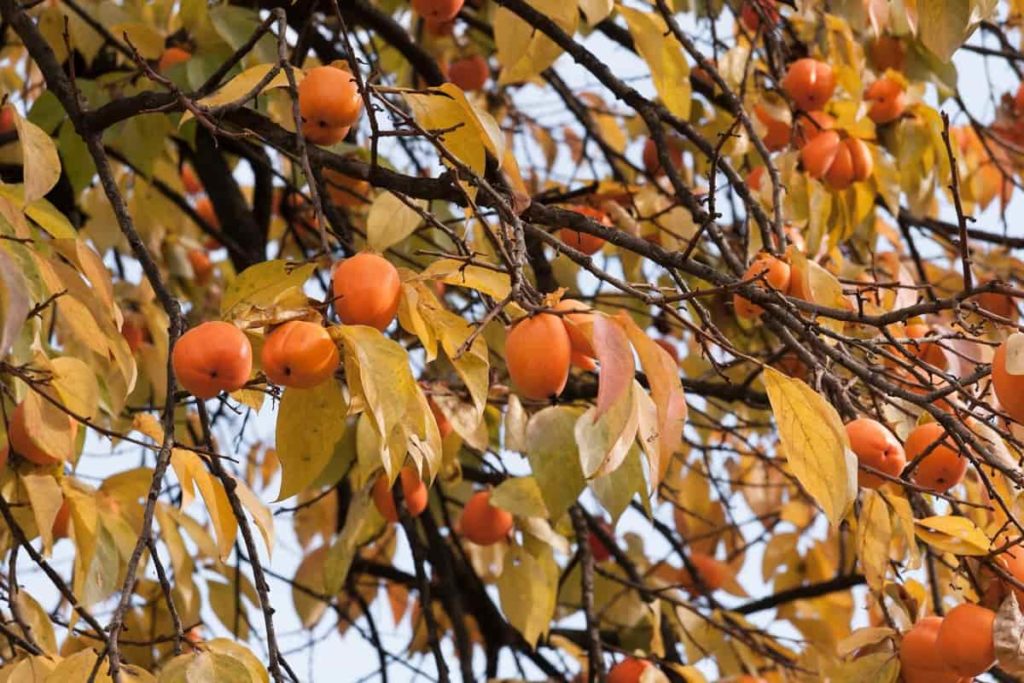
Depending on the variety, this mature tree gives orange-yellow to orange-red fruits during spring and is a favorite for local wildlife. Although Persimmons are generally healthy and harsh, many diseases can damage Persimmon fruits and leaves or even kill trees. Like other fruit trees, Persimmon can also be exposed to an attack from various fungi diseases, which require treatment with fungicides to control and prevent fungus. Let’s check out the common Persimmon tree problems below.
15 common Persimmon tree problems
Curled Persimmon leaves
Persimmon psyllid
Persimmon psyllid is a small, aphid-like pest that feeds on leaves, causing rolled and curled Persimmon leaves. Damage is usually cosmetic and not severe, although new growth can be deformed and stopped.
Solution – The application of dormant oil in late winter or early spring, applied shortly before new leaves appear, will help keep Persimmon psyllid under control. These pests are found anywhere where the Persimmons are grown.
Scales
Scale is another pest that feeds plant juice and may be responsible when the Persimmon leaves are curled. Although pests don’t usually kill Persimmon, they can weaken trees and make them more susceptible to disease and other pests.
Solution – Dormant oil applied in spring is usually a good solution for scale.
Blister mites
Blister mites can cause the leaves of the curled Persimmon, as well as blister shape on the leaf surfaces and yellow or orange spots at the bottom. Small mites lay eggs in spring. Once they are born quickly and are easily distributed through the air from a tree to a tree.
Solution – The damage caused by blister mites is usually cosmetic, and insecticidal soap spray easily controls pests. Spray carefully and thoroughly to reach the hidden pests.
In case you missed it: Best Fertilizer for Persimmon Trees: Homemade, Organic, Natural, Liquid, Compost, How and When to Apply
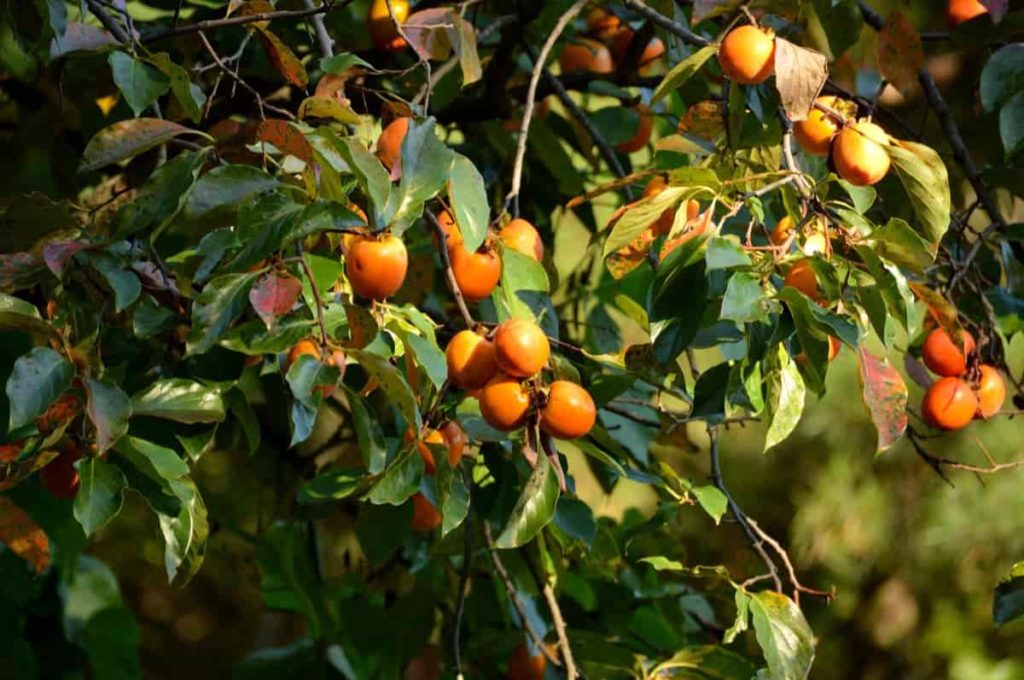
Leafrollers
These leafrollers are the caterpillars of orange tortrix moths. Leafrollers usually don’t need pesticides.
Solution – The safest way to control the leafrollers is to plant nectar-rich plants like Yarrow and Zinnia.
Fertilizer
Young Persimmon trees are sensitive to fertilizer, and too much may cause leaf curl.
Solution – Do not fertilize the Persimmon trees at the time of planting. Once the trees mature, apply a balanced fertilizer in late winter or early spring. You can also use products made for citrus trees.
Drought
While Persimmon trees endure a short drought, excessive dryness can contribute to the curled Persimmon leaves.
Solution – As a common rule, once a week during spring and summer, water Persimmon trees twice as much as the weather when extremely hot and dry.
Persimmon flowers are falling
The amount of sun and water can cause Persimmon flowers to fall or lose fruit. Insufficient sunlight, especially as fruits are produced, can cause the tree to fall fruit in early summer. Both leaves and fruits are affected by prolonged drought conditions. Persimmon grows best in mild conditions. If the weather warms up early, Persimmon can start producing buds that subsequent frosts can damage.
Solution – The Persimmon does not produce well even in the hot summer areas. In these circumstances, bark and fruit will appear sunburned. The Persimmon requires only 36 to 48 inches of water every year. In a mild, moist summer climate, you may have to water the tree only once every six weeks, but in a hot, dry climate may need to be watered two to three times a week. Avoid giving too much water to the Persimmon, as it can cause the yellowing of leaves from iron chlorosis.
Persimmon tree has no flowers
Don’t be disappointed if your Persimmon tree doesn’t have flowers. Oriental Persimmon tree blooms five years later but does not bear fruit until seven years later. Grafted Persimmon trees bloom within two to three years. American Persimmon can take years to bloom and still can’t bear fruit for ten years.
Solution – Both American and Oriental Persimmons have alternate years open and flourish. This means you will get a large crop of small fruits in a year and a year in a row, a small crop of large fruit. Both species bloom in late spring, but the actual time depends on the weather, which can cause un-bloomed Persimmon trees. Sometimes a lack of phosphorus can be responsible for non-blooming. You can remedy this by adding bone meal to the soil around your tree.
Persimmon tree leaves turn yellow
Due to iron chlorosis, leaves turn yellow between veins. You may have some healthy, old leaves that are still dark green, but the new leaves will be pale-white or yellow that is never darken to the dark green of healthy, mature leaves. Over time, yellow leaves can become brown and fall off the tree. The main cause of this problem is the soil with pH, which is very high. Ideally, the soil pH for the Persimmons should be between 6.5 and 7.5.
Solution – Check the soil pH, and if it needs to be lowered, mix well in elemental sulfur at the rate of 15 grams per square foot for sandy-structured soil, 28 grams for soil that are silty, and 60 grams for clay soil. Mixing 28 to 60 grams of chelated iron with 1 gallon of water and several drops of liquid dishwashing soap is another best option. Spray it on the leaves of the Persimmon tree when they are still small and repeat when you start to yellow again between the leaf veins. The spray may have to be repeated regularly during the growing season.
In case you missed it: Persimmon Seed Germination Period, Temperature
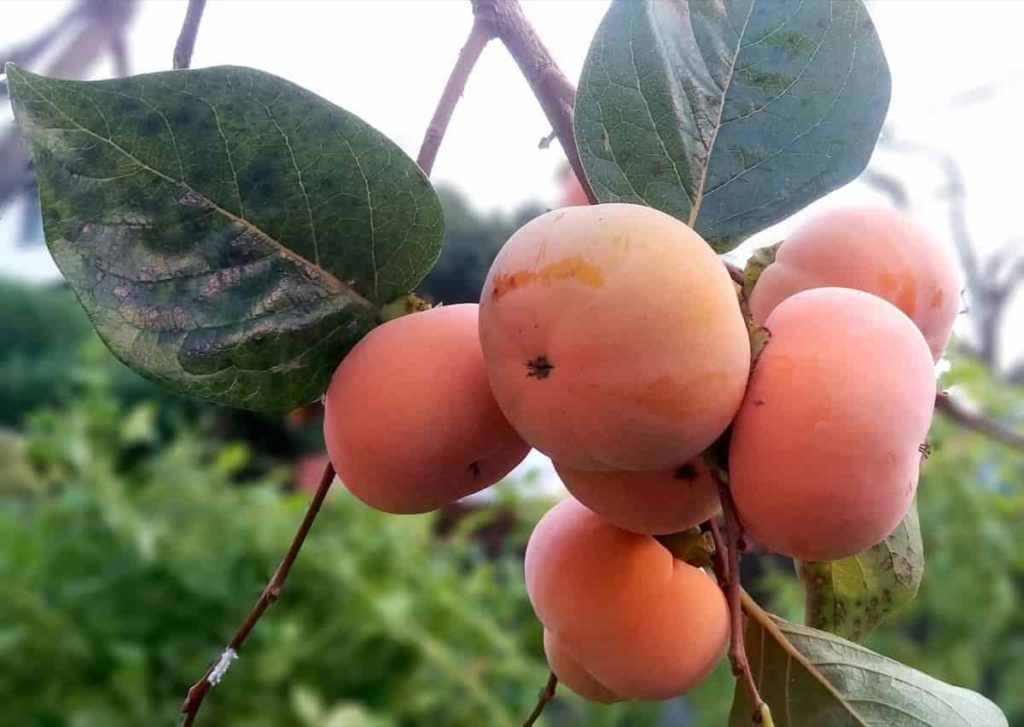
Persimmon fruit drop
Not putting enough or too much fertilizer can cause problems for Persimmon. Excessive nitrogen fertilizer use encourages the tree to produce more leaves, resulting in fruit falling from the tree. Not enough fertilizer makes leaves lighter in color than they should be, which can be considered as yellowing of leaves.
Solution – Best fertilizer for the Persimmon fruit tree is a balanced compost, 10-10-10 or similarly balanced, sprinkled under the canopy in the ratio of 453 grams per trunk diameter, and you should water at the end of winter or early spring. This should be sufficient for the light feeding needs of the Persimmons.
Persimmon dropping its leaves
Whenever you see a tree-like Persimmon dropping its leaves, first look at its cultural care. Persimmons are usually undemanding small trees that tolerate a range of exposure to most types of soil and sun. However, they excel in full sunshine and well-draining loam.
Water
Although Persimmon trees can withstand drought for a short period, they do not perform well without regular irrigation.
Solution -Normally, Persimmon trees need 36 inches of water a year to survive. In times of severe drought, you need to water your tree. You’ll likely see leaves falling from your trees if you don’t.
Poor soil
Although too little water can result in Persimmon leaves falling, too much water can produce the same result. If you plant your Persimmon in the clay area, the water you give to the tree will not pass through the soil. The tree’s roots will get a lot of moisture and rot, which can cause Persimmon leaves to drop.
Solution – You should give water when the soil is dry.
Fertilizer
Too much fertilizer can result in the loss of your Persimmon tree leaves.
Solution – Apply a balanced fertilizer in late winter or early spring. If you have already added nitrogen-heavy fertilizer to your garden soil, don’t be surprised if your Persimmon tree starts losing leaves.
Persimmon fruits are small
The smaller than normal Persimmon fruits are due to the heavy fruit set on a very small tree.
Solution -The common recommendation for fruit trees is to remove all fruits for the first three years.
Dying Persimmon tree
Some early fruit drops are expected, especially in heavy fruit years. However, if your Persimmon tree is continuously dropping fruit and its leaves are turning yellow, you can give your tree more fertilizer or more water. Adjusting soil testing and water drainage problems can help restore your tree, although it may take two years to recover fully.
Solution
- Pruning- Cut back dead and dying branches for live wood. Remove the enlarged vegetation and weeds under the canopy. You should keep the mulch at least two to three inches away from the stem.
- Drainage – Fill the hole with water. If the water drains out in 24 hours or less, the drainage around your tree is fine. If the water takes 24 to 48 hours to drain, the drainage slows down, causing water to log the roots. The water-logged roots will rot, causing the tree to die. You must create a drainage system around the tree that removes excess water from the roots.
- Overwater – While overwater can cause your tree to die, not even enough water can kill your tree. Persimmon trees resist drought, but prolonged drought can cause tree death. Persimmon trees need about 36 inches of water a year to survive. If your area is drought-prone, you’ll need to give your Persimmon tree two to three inches of water a week.
- Overfertilization – The Persimmons should be fertilized once a year, in late winter or early spring, with a balanced commercial fertilizer such as 10-10-10 fertilizer or compost. If you have overfertilized, keep your tree full of water and place an easily removed ground cover like Vinca under the tree canopy to help remove some extra nitrogen. Do not apply fertilizer next year.
- Lack of nutrients
The Persimmons perform well in poor soil, but a lack of nutrients will cause branch diebacks, fruit drops, and yellow leaves. Test the soil and check the pH of soil under the canopy. Before applying fertilizer or compost, you will need to wait until the end of winter or early spring.
In case you missed it: Growing Persimmons in Containers from Seed, Seedlings
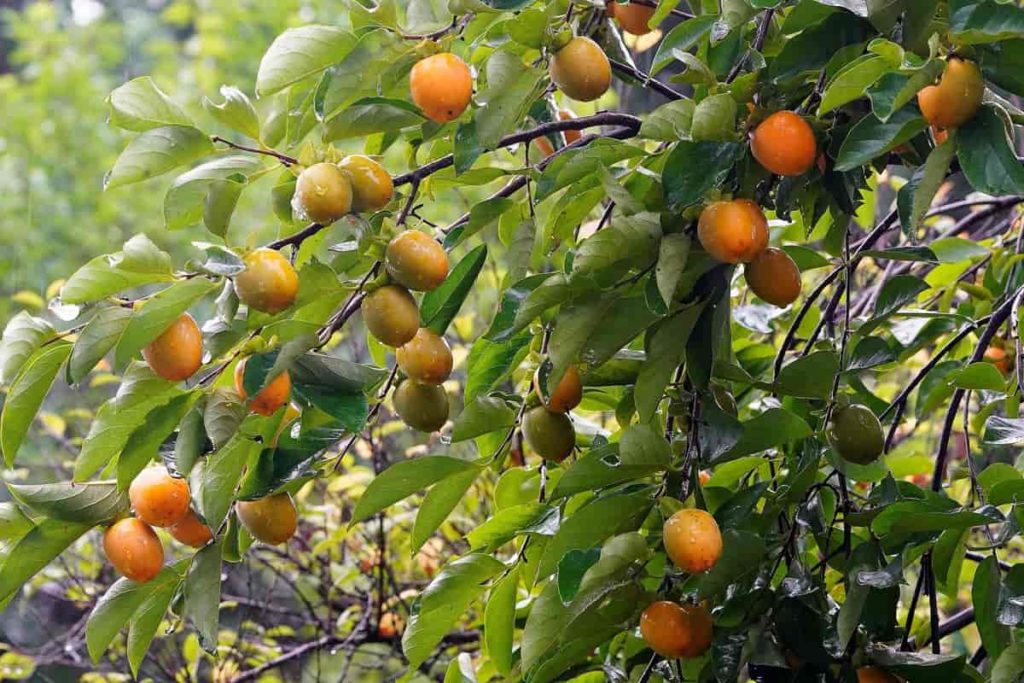
Pests
Fruit fly
The fruit fly is a flying pest that, as its name suggests, feeds the fruit of the trees. But not only that, it leaves its larvae inside the Persimmon, causing it to rot quickly.
Solution – Keep several yellow sticky traps near the tree. So, they will not be able to do anything when they are connected. Another option is to cut the plastic bottle in half, add sugar or honey and water and attach the rope to the tree.
Persimmon sesia
Persimmon sesia is a type of pest whose larvae excavate galleries into the stems. Doing so does them a lot of harm.
Solution – Most recommended is to cut the affected parts with a disinfectant hand with pharmacy alcohol, and the wound is closed with healing paste. It is also advisable to treat the tree with phosphorus pesticides.
Mealybug
The mealybug accumulates on leaves and tender stems. It is protected by a brown or reddish shield and measures only 1 centimeter.
Solution – If they are few or the tree is young, you can remove it with a brush dipped in pharmacy alcohol; if many or plant is adults or large, it is better to treat it with Pyrethrin.
Birds
Birds are very beautiful animals, but the gentlest shoots and fruits can be eaten, especially if they are blackbirds or starlings.
Solution – To avoid this, it is necessary to use protection nets or scarecrows.
In case you missed it: Growing Orange in Pots from Seed – A Full Guide
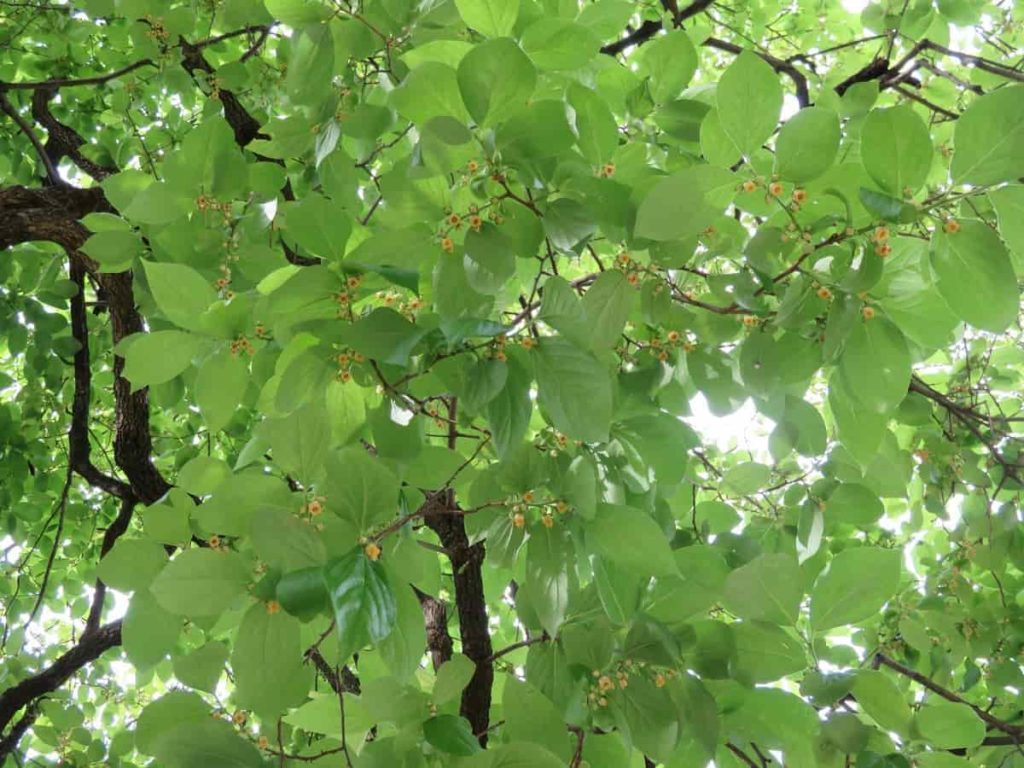
Diseases
Anthracnose
Anthracnose is a disease that creates colorless spots on leaves, stems, fruits, or flowers.
Solution – The most advisable thing is to cut and burn the affected parts and treat them with fungicides.
Botrytis
Botrytis is a fungal disease that produces brown spots on leaves and flowers, usually due to a lack of aeration.
Solution – You must remove the affected parts, treat them with fungicides and avoid wetting leaves and flowers while watering.
Leaf spot
Leaf spot causes black spots to appear on the leaf surface and can sometimes affect fruit as well. This could make the leaves fall quickly.
Solution – Sprays containing baking soda, or pesticide Bordeaux mix are commonly used to control it.
Fungicides to use on Persimmon trees
Oil Fungicides
Various oil fungicides are available, and many Persimmons are safe for use on trees. Horticultural, Jojoba, and neem oil are some of the all-purpose oil sprays you can safely use on fruit trees to control different pests and diseases. Horticultural oil is usually refined petroleum oil, while Jojoba and neem oil is plant-based sprays. Jojoba oil is produced from jojoba bush seeds, and neem oil is obtained from neem tree seeds and fruits. All three oil sprays are less toxic than chemical fungicides and can help control fungal diseases such as mildew, leaf spot diseases, black spots, and rust.
Copper fungicides
Copper fungicides disable the function of fungi enzymes, which prevent spores from germinating. The anti-fungal copper fungicide is generally ineffective for fungal diseases already produced on a tree. Copper fungicides are safe to apply up to 24 hours before fruit harvesting. It is not toxic to birds or flies but is highly toxic to fish and other aquatic wildlife.
Soap fungicides
Soap-based sprays are used as both pesticides and fungicides on all types of plants, including Persimmons. It helps treat sooty mold on all plants and controls different pests such as scales and mealybugs.
Whether you use which fungicides for the Persimmon tree, the improper application will cause more damage than benefit. Every fungicidal has manufacturer instructions that you should always follow to ensure the safety of you and your trees. You should never spray when the temperature is 30°C or above or when the tree is water-stressed. Treating the plant under these conditions can result in burning leaves and fruits.
In case you missed it: Best Fertilizer for Orange Trees: Organic, NPK Ratio, Management, Schedule, How and When to Apply
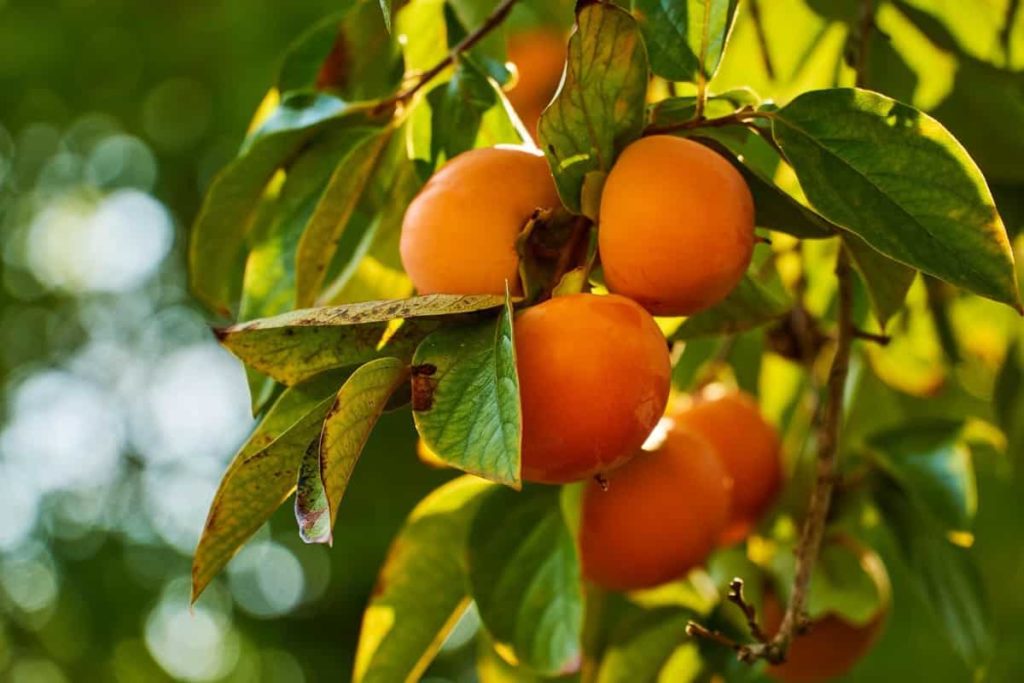
Conclusion
Persimmon fruit tree has the potential for future disease and pest damage. Location and weather will play a key role in issues your tree encounters. If available, disease-resistant Persimmon trees are the best option for easy care; proper care for trees (such as watering, fertilizing, harvesting, spraying, weeding, and fall cleanup) can help keep most pests and diseases at bay.
- How to Grow Hibiscus from Flower
- Plantation Ideas for Home Decoration: A Beginners Guide
- Flower Garden Designs and Layouts for Beginners
- Planting and Spacing Techniques in Papaya: A Beginner’s Guide
- Growing Gold: Essential Techniques for Planting Pineapples
- How to Make Kalanchoe Plant Bushy: Home Remedies and Solutions
- 11 Reasons Why Your Gardenia is Not Blooming: Home Remedies and Solutions
- Eco Elegance: The Guide to Designing a Drought-Tolerant Landscape
- Gardening on a Slope: Strategies for Hillside Landscaping
- Nourish and Flourish: Top Organic Mulches for Thriving House Plants
- Everything You Want to Know about Indian Mogra Flower: Discover Uses and Growing
- Green Thumb Success: Expert Tips for Cultivating Greenhouse Pumpkins All Year Round
- Maximize Growth & Flavor: The Ultimate Guide to Companion Planting in Herb Gardens
- How to Control Rhododendron Problems Naturally: Home Remedies and Organic Ways to Fix Them
- Natural Magic: The Remarkable Benefits of Cinnamon for Plants
- Best Steps to Revive Dying Tulip with Natural and Organic Treatment
- 10 Reasons Why Your Angel Trumpet is Not Blooming: Remedies and Treatment
- How to Fix Periwinkle Leaf and Flower-Related Problems: Natural Remedies and Solutions
- How to Fix Zinnias Leaf and Flower Problems: Discover Natural and Home Remedies
- Organic Steps to Induce Lemon Tree Flowers: A Comprehensive Guide
- Bloom Booster: Crafting the Perfect Homemade Bougainvillea Fertilizer
- Optimizing Growth: A Guide to Applying NPK Fertilizer for Potted Plants
- 10 Best Homemade Fertilizers for Rubber Plant: DIY Recipes and Application Method
- How to Boost Female Pumpkin Flowers: Effective Steps for More Flowers and High Yields
- Transform Your Indoor Garden: Top Benefits of Pink Salt for Houseplants
- 10 Best Homemade Fertilizers for Peacock Plants (Calathea): Easy DIY Guide
- Unlock Blooms: 9 Reasons Why Your Potted Chrysanthemum is Not Blooming
- 8 Reasons Why Your Potted Hibiscus is Not Blooming: Fix it with Simple Solutions
- Unlock Blooms: 9 Key Reasons Your Potted Frangipani Won’t Flower
- 10 Reasons Why Is My Ice Plant Not Blooming: Remedies and Treatment
- 10 Reasons Why My Potted Hydrangea Not Blooming: Treatment and Remedies
- 10 Reasons Why is My Wisteria Not Blooming: Remedies and Treatment
- 10 Reasons Why is My Goldfish Plant Not Blooming: Remedies and Treatment
- Maximize Your Space: Ultimate Guide to Balcony Gardening with Grow Bags
- 10 Reasons Why Your Iris is Not Blooming: Remedies and Treatment
- 10 Reasons Why Your Anthurium Plant is Not Blooming: Treatment and Remedies
my persimmon tree, for the past three years or maybe four, gets full of fruit no bigger than a grape berry. none, not one ever gets any bigger than that. what can i do to get them to get a normal size.